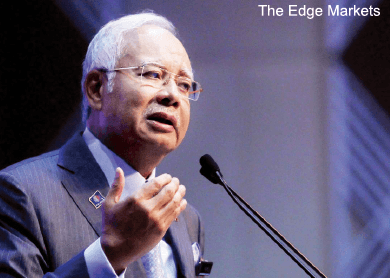
JUST as Malaysians were getting acquainted with the 6% Goods and Services Tax (GST) that took effect on April 1, Parliament approved an additional RM4.14 billion that the government had sought to cover last year’s expenses.
That it was seeking approval for money already spent may come across as odd to some. Eyebrows were raised because the amount was equivalent to 75% of the RM5.5 billion reduction in operating expenditure announced when Budget 2015 was revised on Jan 20. The revision was to take into account the impact of lower crude oil prices on the government’s coffers.
The additional RM4.14 billion sought would also amount to about two-thirds of the RM6.6 billion net additional revenue the government expects to raise from GST this year.
Noted, the RM4.14 billion — RM2.22 billion of which is for operating expenditure and RM1.92 billion for development expenditure — approved was for 2014 and not 2015. As such, the administration still has a chance to prove it is determined to keep its word that it will exercise fiscal prudence. Expectations are high that it will so do.
“Under the current circumstances when people are feeling the pinch of — and having to adjust to — GST, and with the latest Auditor-General’s Report which continues to highlight issues with its findings on spending by ministries and government agencies, the government would do well not to overspend and request a supplementary budget specific to 2015. “It runs counter to the cuts in spending under the revised budget [2015],” says Maybank Investment Bank chief economist Suhaimi Ilias.
Suhaimi had long pointed out that the bulk of the difference in the government’s planned and actual spending between 2000 and 2012 was “higher than budgeted” operating expenditure to cover emoluments, pensions and gratuities as well as subsidies.
It is worth noting that the size of the supplementary budget for 2014 seems to have come down from the over RM20 billion levels seen almost every year from 2008 to 2013. According to Suhaimi, excess spending before 2000 was “not large” and did not exceed RM5 billion. In the early 1990s, there were even times where the government actually spent less than budgeted.
“The government has a tendency to overspend in terms of operating expenditure and we have seen two supplementary budgets every year since 2009. Hopefully, the lower amount of supplementary budget for 2014 is a new trend that will lead to improved budgeting and government spending within its budget in the foreseeable future,” says RHB Investment Bank Bhd executive chairman and chief economist Lim Chee Sing.
That Malaysia no longer needs to subsidise fuel may be one reason the size of supplementary budgets is now smaller, says an observer. Some RM8.85 billion or easily half of additional funds approved in October 2013, for instance, was for fuel subsidies.
“We read that in the US, for instance, there is an urgency to keep to an approved budget because the consequences are severe. There was a partial government shutdown there in 2013 and it narrowly averted another one in 2014. I’m not saying we should go to that extent but the world is watching and the government needs to show greater constraint in its spending and certainly cannot treat supplementary budgets like a rubber stamp – going ahead with spending and then get approval later from a supplementary budget because you need that on paper,” the observer adds.
He recommends that the government increase the current RM2 billion allocated for contingencies every year in the annual budgets.
“Either you tell a fairer picture by allocating more [money for contingencies] or learn to spend within your means. Most of us in Malaysia have to do that because wages are low, more so now that there is a consumption tax,” he adds.
“The RM5.5 billion spending reduction for Budget 2015 (announced on Jan 20) is meaningless if you go ahead and pass supplementary budgets that equal or exceed that amount.”
Including the RM4.11 billion supplementary budget for 2014 passed last year, the RM4.14 billion the government has just approved brings additional spending for 2014 to RM8.25 billion.
To be fair, the supplementary budget for last year is substantially less than the RM26.3 billion requested in two supplementary budgets for 2013, and the RM24.1 billion in two supplementary budgets in 2012.
But even relatively small excesses or mismanagement of resources could result in less money for cash transfers to the lower income group.
The government distributed RM2.09 billion in cash assistance to 4.2 million recipients of 1Malaysia People’s Aid (BR1M) 2012, RM2.83 billion to 6.8 million BR1M 2013 recipients and RM3.64 billion for seven million BR1M 2014 recipients, the official data shows.
Some experts are already concerned that more people in the lower income group could risk bankruptcy if their disposable income is significantly reduced by a consumption tax.
For Malaysia, which faces the possibility of a sovereign ratings cut by Fitch Ratings and is working towards attaining a balanced budget by 2020 in a period of lower oil revenue, the stakes are high. The sceptics doubt Malaysia can keep to its 2015 fiscal deficit target of 3.2% of GDP, especially if sizeable supplementary budgets continue to be a standard feature. It is high time the administration proves the sceptics wrong.

This article first appeared in The Edge Malaysia Weekly, on April 13 - 19, 2015.
Save by subscribing to us for your print and/or digital copy.
P/S: The Edge is also available on Apple's AppStore and Androids' Google Play.